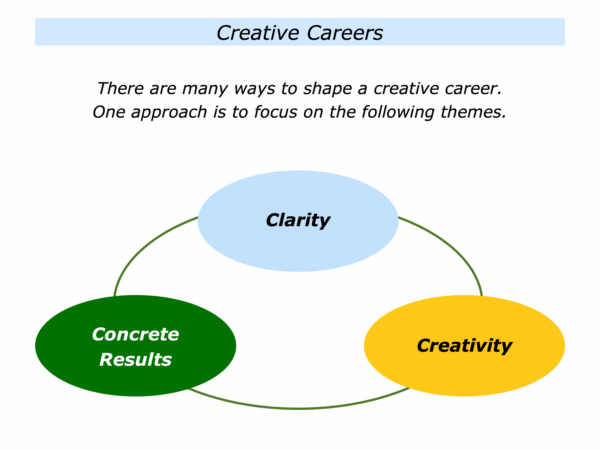
There are many ways to shape a creative career in which you can do satisfying work and achieve your picture of success. One approach involves focusing on the following themes.
Clarity
This involves clarifying what you do and don’t want to do in your career.
Creativity
This involves finding creative ways to do what you want in your career.
Concrete Results
This involves achieving the desired concrete results in your career.
Imagine that you want to follow elements of this approach in your own way. This involves focusing on the following themes.
Clarity
This step involves clarifying what you do and don’t want to do in your career. People like to feel in control and also set parameters. This is an approach you can also take to shaping your career.
Different people give different answers when exploring this theme. Here are some of the things that individuals mention when focusing on how to shape their futures.
Dos – The specific things I do
want to do in my career
I do want:
To do work I enjoy … To do work where I follow my principles … To do work that helps people … To do work that gives me positive energy … To do work where I feel alive and can be creative
To do work where I build on my strengths and earn a reasonable salary … To do work where I can keep developing … To do work where I enjoy the journey as well as achieving success.
Don’ts – The specific things I
don’t want to do in my career
I don’t want:
To do work I don’t believe in … To do work where I feel like a hamster in a wheel … To do work that involves being micromanaged … To do work in an organisation that has a repressive culture.
If you wish, try tackling the exercise on this theme. This step involves focusing on the ‘What’. Dare to brainstorm what you really do and don’t want to do in your career.
Don’t worry about the ‘How’. This is something we will explore later. Here is the exercise on this theme.
My Career
Dos – The specific things I
do want to do in my career
I do want:
To …
To …
To …
To …
To …
Don’ts – the specific things I
don’t want to do in my career
I don’t want:
To …
To …
To …
Let’s assume that you have done this exercise. The next step is to prioritise, for example, the top three things you do want to do in your career.
Different people will prioritise different things. They may focus on following their principles, doing work that helps people, earning a good salary or focusing on other priorities.
If you wish, try tackling the exercise on this theme. This invites you to complete the following sentences.
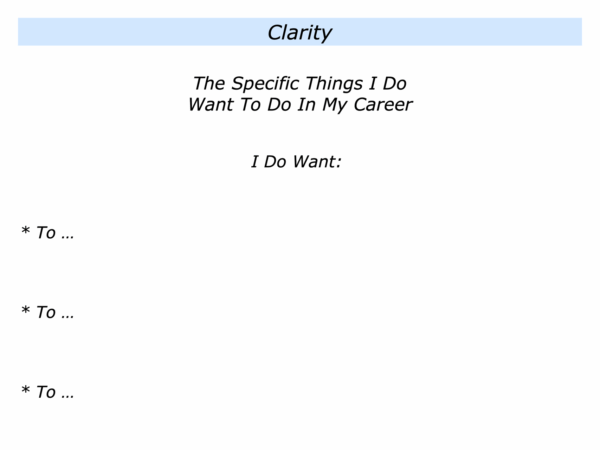
Creativity
This step involves focusing on the ‘How’ and finding creative ways to do the things you want to do in your career. It is also involves recognising what is happening – and what may happen – in the world of work.
There are fewer predictable career paths anymore but there will always be projects. AI means that it will still be important to do work that requires good interpersonal skills, imagination and superb decision making.
So how can you shape your career in such an environment. One approach involves playing to you strengths and having a professional freelancer approach. It is then to find or create satisfying projects and deliver positive results.
Some people take this approach even if they are a full-time employee.
They maintain the freelance mentality and operate as if they are on a rolling contract. They aim to behave in a professional way and help their stakeholders to succeed.
There are many creative ways to aim to do the things you want in your career. The following section explores The Principles Approach, The Vocation Approach and The Strengths Approach. There are, of course, many other ways.
Whatever approach is taken, however, it often involves focusing on the What, How and When. This calls for being creative when exploring the following questions.
What
What are the specific things I do want to do in my career?
How
How can I do my best to do these things in my career?
When
When do I want to do these things in my career?
Bearing this approach in mind, let’s explore the following approaches to shaping your career.
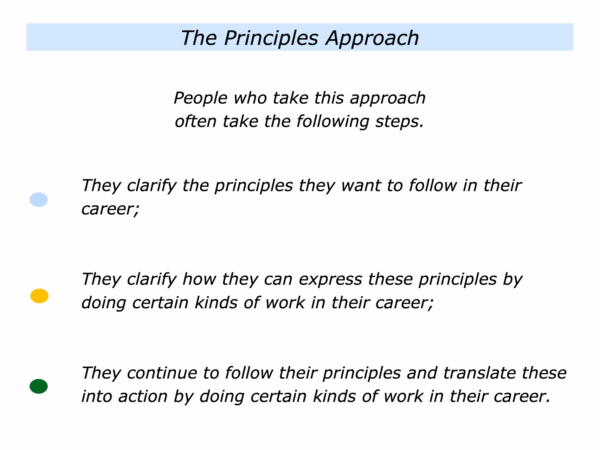
Some people aim to follow their principles and express these by doing certain kinds of work in their career. Such people recognise that the way these principles may also change in the evolving world of work.
Imagine the scene. A person is being interviewed for a specific role in an organisation. At some point the interviewer may aim to clarify the person’s ambitions by asking some of the following questions.
“Where do you see yourself in five years? What is the role you would like to be in then? What are your career goals?”
Some individuals answer such questions by saying they would like to have gained promotion and be in a senior role. They may take this approach to show they are ambitious.
A person who follows the principles approach may answer such questions in a different way. They may say something along the following lines.
“As we know, the world of work is evolving, so it is hard to describe the actual job I will be doing. What I can say, however, is that it will be a role where I am following certain principles. For example, it will be a role where:
“I am working with a pacesetting company that is doing pioneering work in its field. I am leading a superb team that does great work that helps the company and its customers to achieve success.
“I am creating a positive environment that enables people to develop and, in some cases, move on to take more senior roles in the company.
“As I said, I am not sure what they actual role will be, but it will be embodying those principles that I have tried to follow in my professional life.”
People who take this approach have clarified the principles they want to follow. They then aim to express these in doing positive work and, in the process, shape their professional career.
Such individuals aim to keep developing and are also good at reading reality. As mentioned earlier, they recognise that:
The principles they aim to follow may, for them, be eternal;
The ways they express these principles may evolve, however, as the world of work also evolves;
They may need to keep developing as professionals in order to deliver excellence.
People who take this approach believe in a certain kind of consistency. They involves them following consistent principles that come from within themselves. They are committed to development, however, and are able to apply the principles in pragmatic ways to deliver positive results.
Such people recognise that the world of work is changing. Bearing this in mind:
They focus on how they can follow their principles in their present work and help their stakeholders to achieve success;
They focus on how they can follow their principles in the future to help potential employers or customers to tackle challenges or achieve their goals;
They focus on how they can continue to express their principles in modern ways in order to deliver excellence and help people to achieve success.
You will have your own set of principles that you want to follow in your work. You may then express these by doing certain kinds of work in your career.
If you wish, try tackling the exercise on this theme. This invites you to complete the following sentences.
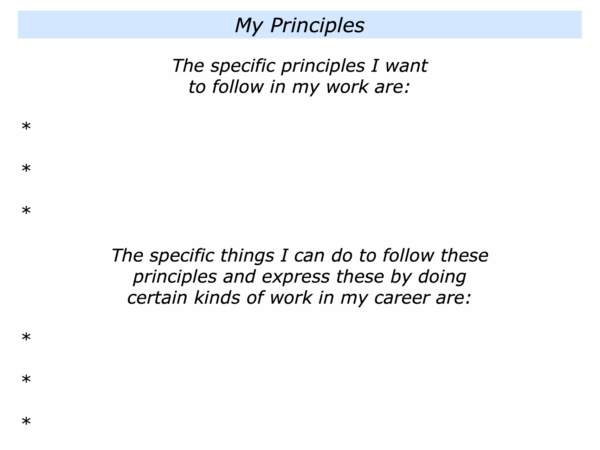
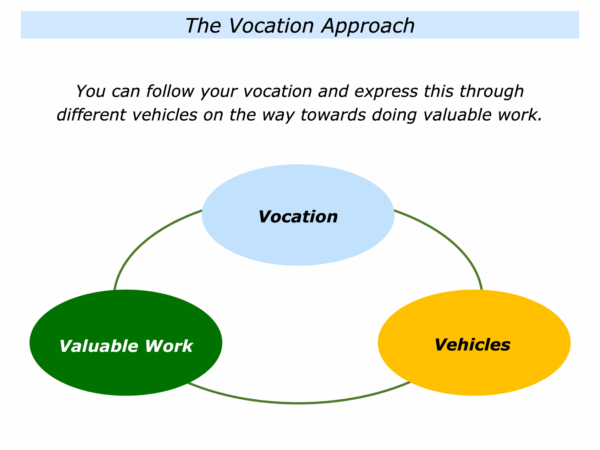
A person’s vocation is their calling. It is what they are here to do. Their vocation may remain constant throughout their life. They may express this through various vehicles, however, on the way towards doing valuable work.
A person never retires from their vocation. They just find more ways to express it during their life. Let’s explore these themes.
Finding Your Vocation
There are relatively few vocational themes but the way a person expresses these will be unique. Most of the themes revolve around the eternal human activities. These include, for example:
Encouraging … Nurturing … Educating … Exploring … Creating … Designing … Orchestrating … Building … Implementing … Problem Solving … Communicating … Performing … Or Doing Other Activities.
How to find your vocation? One approach is to focus on several satisfying projects that you have done in your life. Looking at what made these satisfying can reveal your successful style of working. It can also provide clues to your vocation. Here is an exercise on this theme.
My Successful Style
This is a long but worthwhile exercise that highlights when you have translated your strengths into action. It invites you to do the following things.
Describe two satisfying projects
you have done in your life
The word project can be used in its widest sense. For example: writing an article, organising a fun run, launching a web site, solving a particular problem, leading a team or whatever.
Describe each of these projects in turn and
the things that made each of them satisfying
Try to be as specific as possible, especially about the things that made them satisfying. Looking at these projects, can you see any recurring patterns? These provide clues to your preferred style.
Describe your successful style of working and the
principles you follow when doing satisfying work
You may, for example, find it satisfying to do something you really care about, be in a positive environment, set a stimulating goal, follow a certain rhythm and do your best to achieve your picture of success.
Describe how you can follow
these principles in the future
This part invites you to consider how you can keep following your principles and do satisfying work. This is something you can do to pursue personal projects.
If you want to get paid for doing professional work, however, it may mean finding or creating a project where you can follow your preferred style. This will also mean delivering specific benefits that help the potential sponsors – employers or customers – to succeed.
Here is the exercise on this theme. You can use this to clarify your successful style of working. Bearing this in mind, you may continue to follow your successful style in the future.
It is possible, however, that you will express it differently in different situations. The key, however, will be to follow your successful style on the way to doing satisfying work and achieving success.
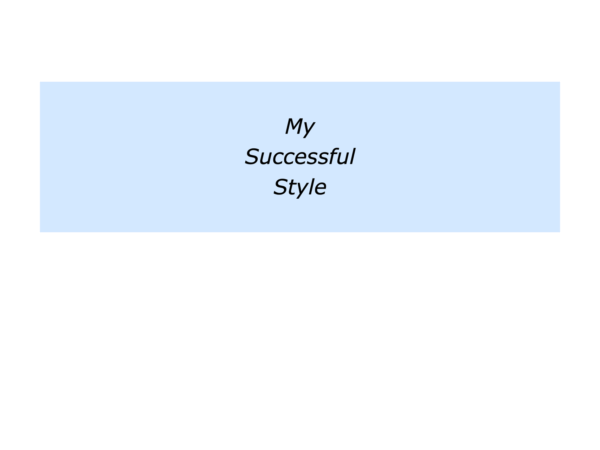
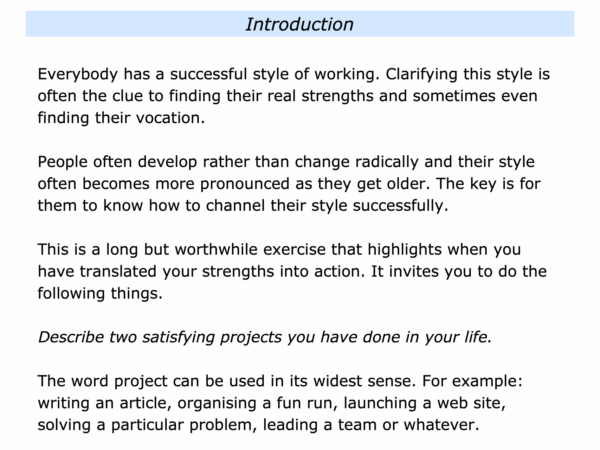
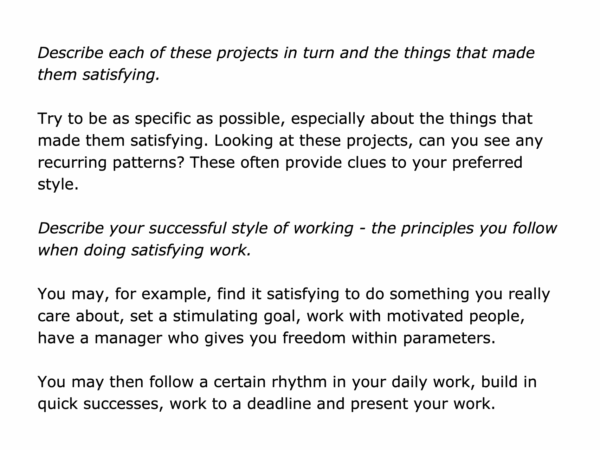
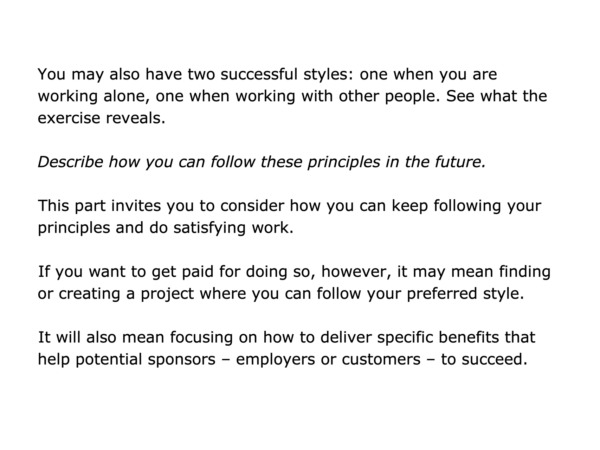
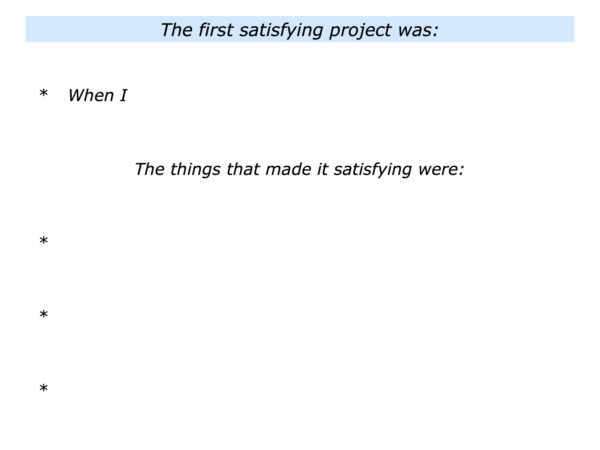
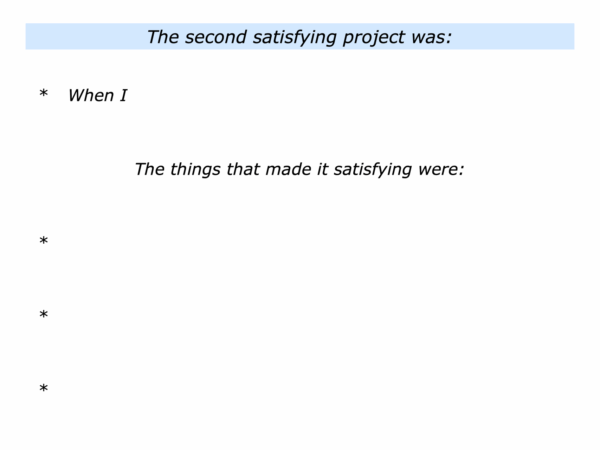
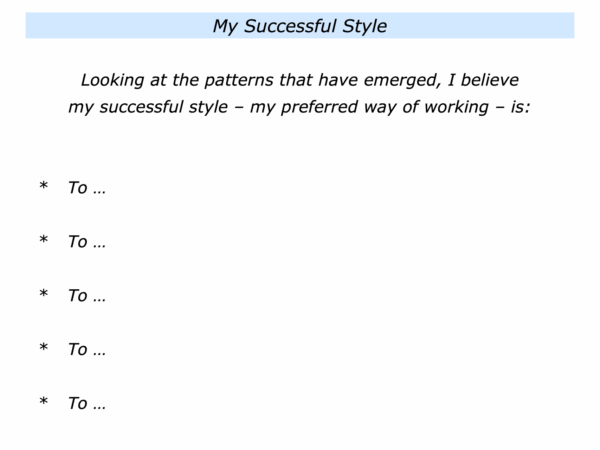
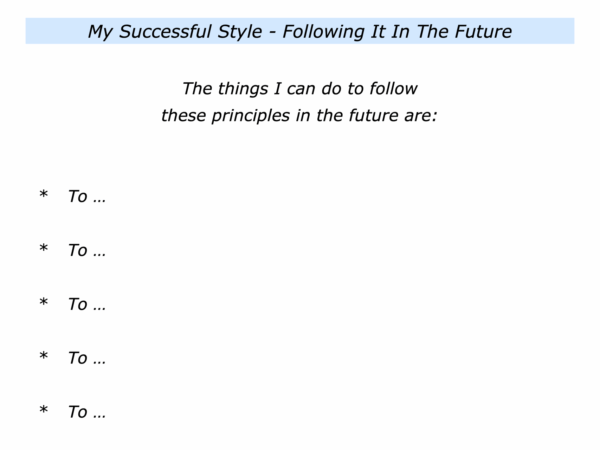
How to clarify your vocation? Looking at your satisfying projects, it is:
To clarify a recurring theme in terms of what made them satisfying … To clarify the specific things you aimed to do when pursuing that theme … To clarify your possible vocation.
Here are some of the examples of vocations that people give when exploring this topic.
My Vocation Is:
To encourage people to become the best they can be … To create enriching environments in which people grow … To build successful prototypes that show a better way.
To share knowledge that people can use to maintain their wellbeing … To help people to become the architects of their lives … To design sustainable systems that deliver ongoing success.
To design things that are simple, satisfying and successful … To create beautiful things that inspire people … To do practical work that helps to makes the world a better place.
Imagine that you have begun to clarify your vocation. It can then be time to move on to the next stage.
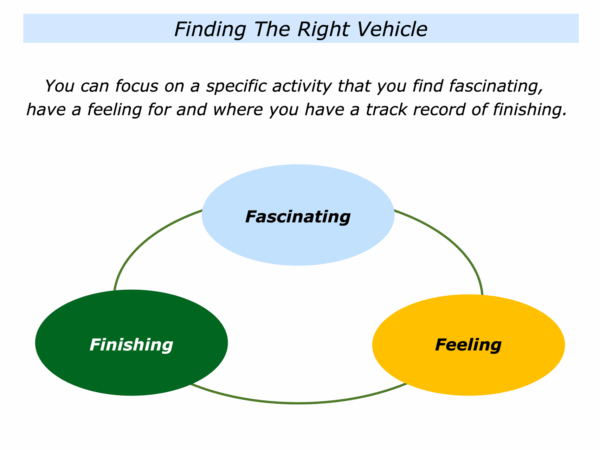
Different people express their vocation through different vehicles on the way to doing valuable work. Let’s look at one example. Imagine that your vocation may be:
To create enriching environments in which people grow.
You can express this theme through many different vehicles. For example, you may choose:
To be an educator … To be an interior designer … To create inspiring music … To do landscape gardening … To lead a successful team in which people perform at their best … Or whatever.
There are many ways you can express your vocation. One approach is to focus on: a) your chosen field of activity; b) your chosen form of activity. The following section describes how you can take these steps.
You Can Focus On Your
Chosen Field Of Activity
There are several ways to find a field in which you may feel and ease and able to excel. One approach is:
To focus on the specific activity that you find fascinating, have a feeling for and have a track record of finishing.
Imagine you want to explore this approach. This involves focusing on the specific activities that have the following characteristics.
You find the activity fascinating
What are the things that fascinate you? What are the activities where you want to explore and make sense of things? What are those where you want to build models?
One clue is to choose a field where you would pursue this activity even if you did not get paid for doing it. It is a positive addiction.
Derek Jacobi, the actor, explained this approach in a television interview. When approached by young people who want his advice on becoming an actor, he said something like the following.
“If you want to become an actor, then don’t do it. If you need to become an actor, then do it.”
You have a strong feeling for the activity
Looking at the field of activity you have chosen, do you have a strong feeling for it? Are you good at it? If so, begin to explore how you can do more of this kind of work.
If not, take the time to pursue other fascinating activities. Looking at these activities, where do you have the ability to do good work that is fulfilling? Settle on one you want to explore further.
You have a track record of finishing
Let’s return to the activity you find fascinatin and have a feeling for. Is it one where you also have a track record of finishing? Here is an example given by one person.
“I have a good record of building and selling successful prototypes. This normally takes between two and three years.
“I did run one company for five years. But scaling the business meant I got involved in the maintenance aspects. My staff took care of the day-to-day work, of course, but I lost interest in running the business.
“Some people create and sell larger businesses for massive sums, but that is not my forte. I prefer to build prototypes, provide proof of concept and then sell to buyers. This is what I am good at finishing.”
Superb workers have natural strengths in their chosen activity. They love to explore the various scenarios they may encounter when doing the activity.
They prepare properly before embarking on the activity. Looking ahead, they practice the strategies and skills they may need to achieve the desired results..
Such workers follow their chosen ritual for moving into action. They then concentrate fully and do their best to perform superb work. They sometimes combine being able to helicopter above the situation with being hands-on.
Some people go into an almost spiritual dimension. Looking back later, they say things like:
“It was like an out-of-body experience … I seemed to do things slowly but others say I do them swiftly … Time went away and I went into a state of flow.”
Let’s return to your own life and work. Are there any activities where you may have this ability? How can you do more of these in the future? How can you continue to do superb work in the activity where things go slowly yet swiftly?
You Can Focus On Your
Chosen Form Of Activity
Imagine that you have some clues about your vocation. You can then aim to choose a form of activity that fits your successful working style.
You may prefer to express your talents by teaching, leading, managing, writing, speaking, designing, making films or doing another activity. You may prefer to work alone, to be a leader, to work in a team, to work in an organisation or follow another path.
Clarifying one’s vocation can be a lifetime search but some clues can be found quickly. You can focus on the activities that give you positive energy and make your heart sing.
While the theme may remain constant, the way you express this may change over the years. If you wish, try tackling the exercise called My Vocation. This invites you to do the following things.
Describe what you
believe may be your vocation
Looking back at the satisfying projects you have done in your life, can you see any themes? Are there any read threads that runs through the projects? Do these give any clues to your possible vocation?
If so, describe what you believe may be your vocation. Don’t worry too much about the actual wording – that can take years – have a go at describing your vocation. Describe the times you may have expressed this vocation in various activities or projects.
Describe the possible vehicles
you can use to express your vocation
You may already use a tried and trusted vehicle. This may be writing, painting, gardening, building, encouraging people, teaching, solving problems, broadcasting, communicating or whatever. Focus on the vehicles that you feel most attracted to using.
Describe the specific things you can do to deliver valuable
work when expressing your vocation through these vehicles
It is important to follow your chosen rhythm. You may wish to prepare properly, organise your time in blocks, work with particular people or do certain things to produce superb quality work.
Here is the exercise on these themes. It invites you to complete the following sentences.
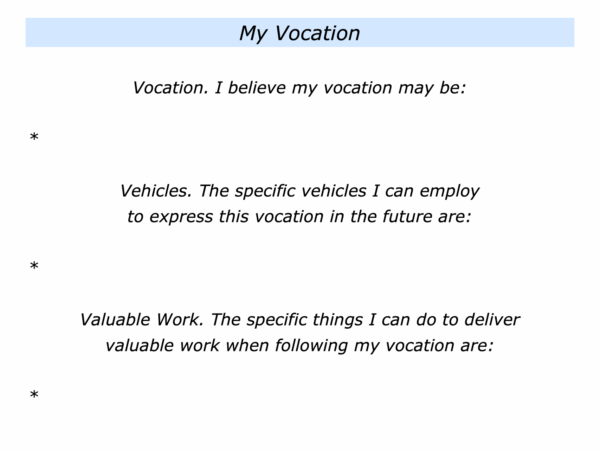
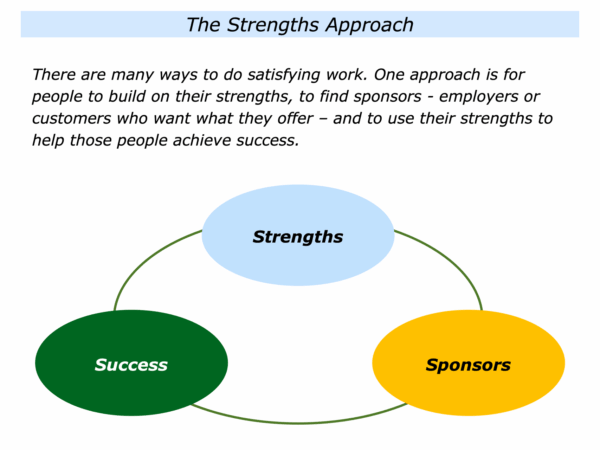
“The world of work keeps changing,” some people say. “It is hard to know what skills people should learn to shape their futures.”
Perhaps. As the saying goes, however, the more things change, the more some things stay the same.
Creative people throughout history have followed certain themes to earn a living doing what they love. They have built on their strengths and found sponsors – employers or customers – who hired them for doing what they did best. They then helped those sponsors to succeed.
People who develop such eternal skills are more likely to shape their futures. Let’s explore how this works in action.
Strengths
Michelangelo, Anita Roddick and Steve Jobs had at least one thing in common. They did what they did best and got somebody to pay them for doing it. Some customers will always be interested in buying quality. And the best way of producing quality is to develop your top talents.
How can you clarify your strengths? One approach is to identify the deeply satisfying activities in which you deliver As rather than Bs or Cs.
You may be good at counselling, gardening, making furniture, singing, coaching a sport or developing software. You may be good at selling, customer care, nursing, leading certain kinds of teams or doing another activity.
Here are some questions you can ask to begin clarifying your strengths. You can then move on to clarifying the specific things you can deliver that will help people to succeed.
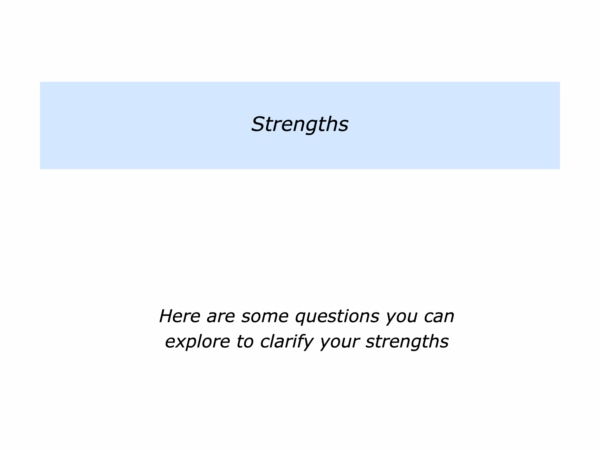
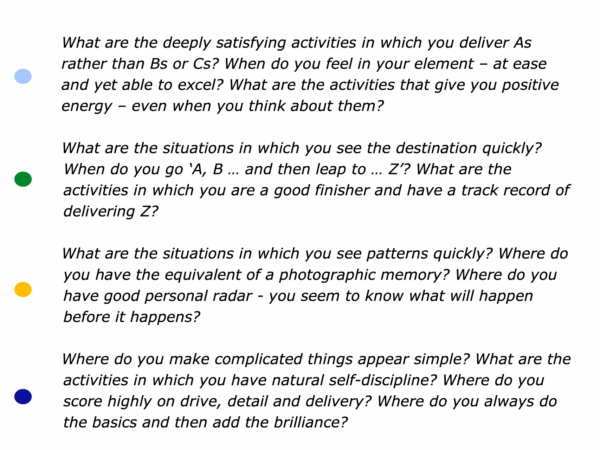
Sponsors
Anybody can do work they love, the art is getting somebody to pay you for doing it. Creative artists have faced this challenge throughout history.
How to find sponsors – employers or customers – who will hire you for what you do best? One approach is to start by clarifying your perfect customers or employers.
Who are kinds of customers with whom you work best? What are the characteristics of these people? When have you done good work for such people? What did you do to help them to achieve success?
If you mainly work within an organisation, what is the kind of manager with whom you work best? What are the characteristics of such a manager? What makes it good to work with them?
Here are answers that individuals give to these sets of questions.
“I work best with achievers. They love to set goals, work hard and achieve success. Being adrenaline driven myself, I enjoy working with others who like to stretch themselves to achieve success.”
“I work best with pioneering leaders. Such people often aim to be pacesetters. It is exciting to work with such people who are aiming to make the new rules for the game.”
“I work best with people who have humanistic values. They often want to create workplaces that encourage people. At the same time, however, they are prepared to take tough decisions.”
Imagine you have clarified your perfect customers or employers. Looking at the world from their point of view, what are the challenges they face? How can you help them achieve their goals?
Imagine you are working with external customers. What are the pressures they face? What are their present and future needs? What are their professional goals?
Imagine you are mainly working within an organisation. Your internal customers are your colleagues, manager and the directors. What are their challenges? What are their professional goals?
Most employers want to improve the Three Ps. They want to improve their profits, product quality – including processes and service quality – and people. How can you help them to tackle these challenges and also achieve the organisation’s goals?
Imagine you have identified your potential sponsors. How can you reach them in a way that fits with your values system? How can you create a showcase – a shop window – for your work? How can you give to people and help them to succeed?
Later we will go into greater depth regarding how to reach people in ways that work for you. Before then, however, here are some themes you can explore to clarify your potential sponsors.
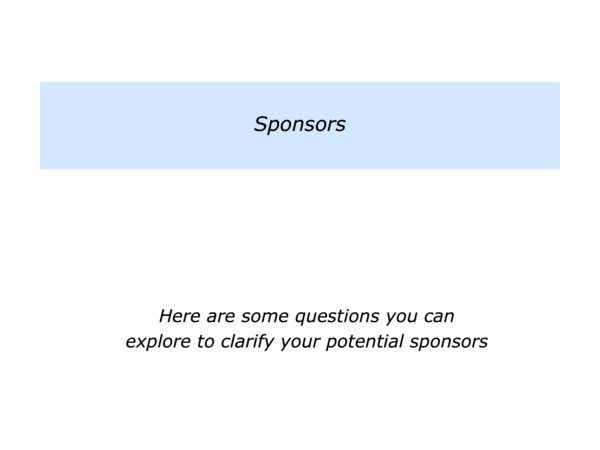
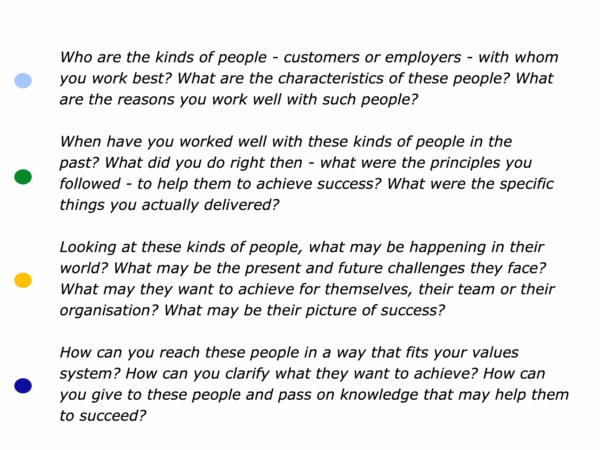
Success
Imagine you have settled on your potential sponsors. How can you use your strengths to help them to tackle their challenges? How can you help them to achieve their goals?
Great workers provide specific services or products that help their potential sponsors: to solve problems, to have positive experiences or to achieve their picture of success.
Depending on their strengths, different people help others in different ways. They focus on what people may need or want. They then provide practical help or knowledge that helps them to achieve their aims.
A doctor may help people to regain their health. A chef may offer people wonderful food. A sports coach may help athletes to perform at their best.
A project director may ensure strategies are delivered on time. A crisis manager may solve problems that threaten an organisation. A film maker may produce films that give people pleasure.
Looking at my work, the aim has been to encourage and enable people to achieve their goals. This has taken the form of providing practical tools that people, teams and organisations can use:
To build on their strengths; To do satisfying work; To build superb teams and organisations; To find solutions to specific challenges; To achieve their picture of success.
There is a vast repertoire of positive models that can help people to reach these goals. The aim has been to pass on practical tools that people can use in their own ways to achieve ongoing success.
Imagine that you have managed to meet with potential sponsors. It will be important:
To show that you understand the world from their point of view – such as their challenges and goals;
To, if appropriate, share how what you offer can help them to achieve their goals;
To, if they want to move things forward, make clear contracts on the specific things you will deliver to help them to achieve their goals.
To get some quick successes, provide great service and proactively keep them informed about the progress being made towards the goals;
To do superb work, find solutions to challenges, deliver the agreed goals and then add that touch of class.
You will do this in your own way. But here are some themes it can be useful to explore on the road to help them to achieve success.
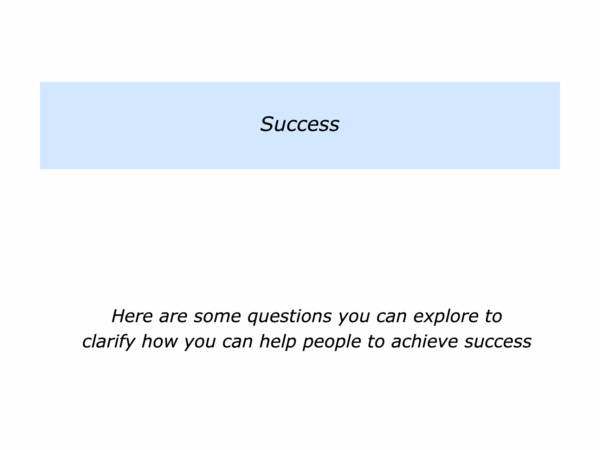
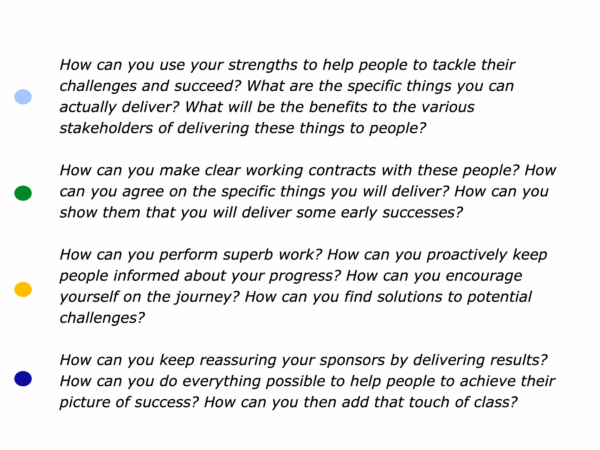
Imagine that you want to build on your strengths and do satisfying work. You also want to help others to achieve success.
If you wish, try tackling the exercise on this theme. This invites you to explore the following themes.
Strengths
Describe the satisfying activities in which you have the ability to deliver As. These may be particular kinds of projects, tasks or other activities. Try to be as specific as possible and give concrete examples.
Describe the activities in which you deliver Bs or Cs. The B activities are probably those that you can do reasonably well but may not necessarily be satisfying. The C activities are those where you have little aptitude or desire to learn.
Sponsors
Describe the kinds of people – customers or employers – with whom you work best. These may be people with certain personality characteristics or other qualities. Describe the challenges they face or the goals they want to achieve.
Success
Bearing in mind your strengths, describe the specific things you can deliver to help these people. There are many ways to define what you offer.
One approach is to answer the following question. What are the specific things you can deliver to help your customers to achieve success? If you wish, try completing the following exercise.
My Offering
The specific things I can deliver to help
my customers to achieve success are:
*
*
*
The emphasis is on what you can deliver not just what you can do. Lots of people can do lots of things, but customers or employers buy what you can deliver.
Here is a shortened version of the exercise on these themes. This invites you to complete the following sentences.
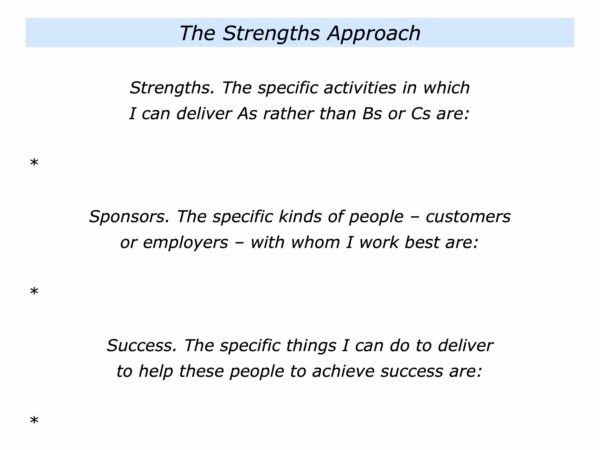
There are creative ways to aim to do the things you want in your career. This section has explored some of these approaches. There are, of course, many other ways.
As mentioned earlier, whatever approach is taken it often involves focusing on the What, How and When. This calls for being creative when exploring the following questions.
What are the specific things I do want to do in my career?
How can I do my best to do these things in my career?
When do I want to do these things in my career?
If you wish, try tackling the exercise on this theme. This invites you to describe who you can be creative and aim to do the things you want in your career.
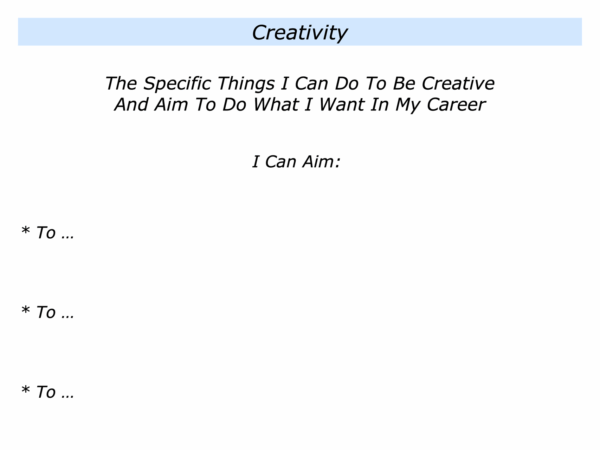
Concrete Results
This step involves doing your best to achieve the desired concrete results in your career. Different people will, of course, aim to achieve different kinds of results. Here are some things they may mention.
The specific kinds of results I want to do
my best to achieve in my career are:
To simply encourage people … To use my talents to create beautiful things … To create inspiring experiences that give people positive memories for life.
To help people to heal … To help to create medical breakthroughs that cure certain illnesses … To create sporting academies that also equip young people with skills they can use in their future lives.
To produce technology that simplifies people’s lives … To make films that inspire people to care for the planet … To pass on knowledge that people can use to shape a positive future.
There are many way to shape your career. One approach is to start by clarifying the specific things you do want to do in your work. It is then to clarify the creative ways you can aim to do these things.
Imagine that you have explored these themes. You can then move on to the final step. This involves clarifying how you can do your best to achieve the desired results in your career.
If you wish, try tackling the exercise on this theme. This invites you to complete the following sentence.
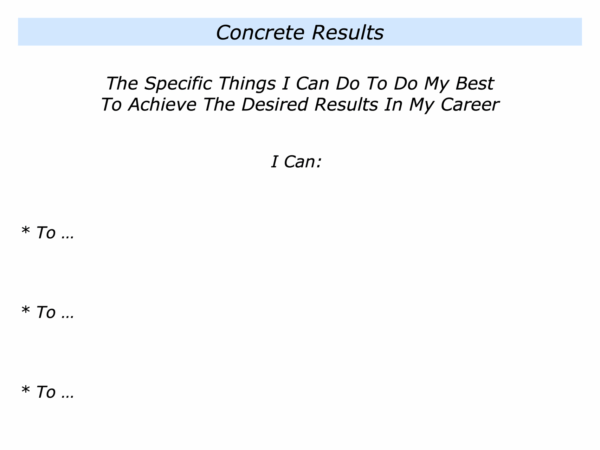


Leave a Reply